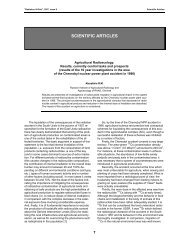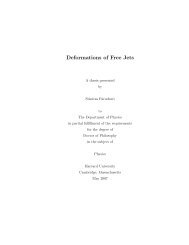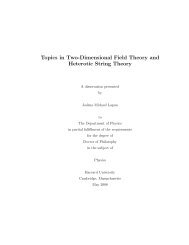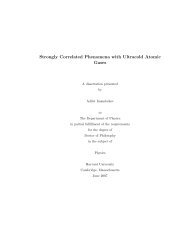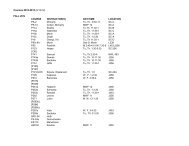Solution Week 46 (7/28/03) The birthday problem (a) Given n people ...
Solution Week 46 (7/28/03) The birthday problem (a) Given n people ...
Solution Week 46 (7/28/03) The birthday problem (a) Given n people ...
You also want an ePaper? Increase the reach of your titles
YUMPU automatically turns print PDFs into web optimized ePapers that Google loves.
If we take the natural log of this equation and use the expansion,<br />
then the requirement Pn ≤ 1/2 becomes<br />
�<br />
1<br />
−<br />
N<br />
+ 2<br />
N<br />
Using the sums,<br />
ln(1 − x) = −(x + x 2 /2 + · · ·), (3)<br />
�<br />
n − 1<br />
+ · · · −<br />
N<br />
1<br />
�<br />
1<br />
2 N<br />
n�<br />
k =<br />
1<br />
n(n + 1)<br />
2<br />
we can rewrite eq. (4) as<br />
n(n − 1)<br />
2N<br />
, and<br />
4 (n − 1)2<br />
+ + · · · 2 N 2 N 2<br />
n�<br />
k<br />
1<br />
2 =<br />
�<br />
n(n + 1)(2n + 1)<br />
6<br />
− · · · ≤ − ln 2. (4)<br />
, (5)<br />
n(n − 1)(2n − 1)<br />
+<br />
12N 2 + · · · ≥ ln 2. (6)<br />
For large N, the first term will be of order 1 when n ≈ √ N, in which case<br />
the second- and higher-order terms are negligible. <strong>The</strong>refore, keeping only the<br />
first term (which behaves like n 2 /2N), we find that Pn is equal to 1/2 when<br />
Let’s look at a few cases:<br />
n ≈ √ 2 ln 2 √ N. (7)<br />
• For N = 365, eq. (7) gives n = 22.5. Since we must have an integral<br />
number of <strong>people</strong>, this agrees with the exact result, n = 23.<br />
• For N = 24 · 365 = 8760 (that is, for births in the same hour), we find<br />
n = 110.2. This agrees with the exact result, n = 111, obtained by<br />
multiplying out eq. (2).<br />
• For N = 60 · 24 · 365 = 525, 600 (that is, for births in the same minute),<br />
we find n = 853.6. This agrees with the exact result, n = 854, obtained<br />
by multiplying out eq. (2) (not by hand!). This is a very small number<br />
compared to the more than half a million minutes in a year.<br />
Remarks:<br />
(1) If we wish to ask how many <strong>people</strong> need to be in a room in order for the<br />
probability to be at least p that some two have the same <strong>birthday</strong>, then the<br />
above derivation is easily modified to yield<br />
n ≈<br />
�<br />
2 ln( 1<br />
1−p )√ N. (8)<br />
(2) <strong>The</strong> alternative question introduced in part (a), “How many <strong>people</strong> need to be<br />
present for there to be a 1/2 chance that someone else has my <strong>birthday</strong>?”, may<br />
also be answered in the large-N limit. <strong>The</strong> probability that no one out of n<br />
<strong>people</strong> has a <strong>birthday</strong> on a given day is<br />
�<br />
1 − 1<br />
�n �<br />
= 1 −<br />
N<br />
1<br />
�N(n/N) ≈ e<br />
N<br />
−n/N . (9)<br />
2



